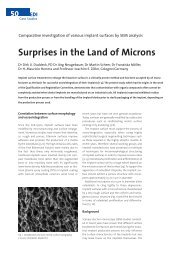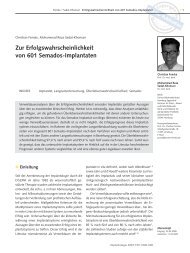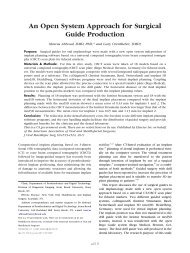implantaten und Aufbau - BEGO
implantaten und Aufbau - BEGO
implantaten und Aufbau - BEGO
Sie wollen auch ein ePaper? Erhöhen Sie die Reichweite Ihrer Titel.
YUMPU macht aus Druck-PDFs automatisch weboptimierte ePaper, die Google liebt.
10 Originalia – Materials Science<br />
Voltage [mV]<br />
300<br />
200<br />
100<br />
0<br />
–100<br />
Implant against CoCr in NaCl<br />
Sample 1<br />
Sample 2<br />
Sample 3<br />
Sample 4<br />
Current [nA]<br />
for the CoCr alloy at acidic pH values, the corrosion<br />
currents doubled for titanium superstructures<br />
and tripled for the precious-metal alloy.<br />
The results of this investigation indicate that<br />
prefabricated CoCr superstructures can be used<br />
on implants at least as safely as titanium or<br />
high-gold precious-metal alloys.<br />
Acknowledgement<br />
We wish to thank Bego Implant Systems in Bremen<br />
for supplying the implants and the prefabricated<br />
implant superstructures.<br />
Fig. 5 Result of measurements on four implant/CoCr<br />
alloy pairs in normal saline solution.<br />
The short-circuit currents were extrapolated for<br />
decreasing voltages with increasing currents<br />
against a voltage of 0 V. The free surface area of<br />
the superstructure was 2.2 cm 2 .<br />
med that all the corrosion currents would be<br />
smaller on smooth surfaces [1]. It therefore follows<br />
that the form of surface treatment selected<br />
by us simulated a particularly unfavourable<br />
situation and the current densities to be expected<br />
in the clinical situation are smaller.<br />
Clinical relevance<br />
When using implants, it must be remembered<br />
that CoCr superstructures in combination with<br />
titanium implants display smaller corrosion<br />
currents than is the case with superstructures<br />
made of titanium or a high-gold alloy. Whereas<br />
no increase in the corrosion current was fo<strong>und</strong><br />
Literatur<br />
1 Borchers. Metallk<strong>und</strong>e II, Berlin: Walter de<br />
Gryter&Co. 1969<br />
2 Heitz et al. Korrosionsk<strong>und</strong>e im Experiment. Weinheim:<br />
VCH, 1990<br />
3 Hesse (Hrsg). Giesserei Lexikon. Fachverlag Schiele<br />
& Schoen, 2000<br />
4 Kulmburg et al. Untersuchung der Korrosionsbeständigkeit<br />
von Rein-Titan. Stomatologie 2006;<br />
103: 71–76<br />
5 Kulmburg et al. Die Korrosion von Nichtedelmetall<br />
(NE)-Legierungen. ZWR 1986; 95: 544–550<br />
6 Taher, Al Jabab. Galvanic corrosion behaviour of<br />
implant suprastructure dental alloys. Dental Mat<br />
2003; 19: 54–59<br />
7 Venugopalan et al. Evaluation of restaurative and<br />
implant alloys ganvanically coupled to titatnium.<br />
Dent Mat 1998; 14; 165–172<br />
Peer-reviewed paper<br />
Address for correspondence<br />
Prof. Michael Gente<br />
Abt. für Zahnersatzk<strong>und</strong>e, Bereich für Propädeutik<br />
<strong>und</strong> Kiefer-Gesichts-Prothetik<br />
Medizinisches Zentrum für ZMK-Heilk<strong>und</strong>e<br />
Georg-Voigt-Str. 3, 35033 Marburg/Lahn, Germany<br />
E-mail: michael@gente.de<br />
Impressum<br />
Schriftleitung <strong>und</strong> Redaktion<br />
Dr. med. dent. Cornelia Gins<br />
Platanenallee 39, 14050 Berlin<br />
Tel.: 030/3041600, Fax 030/3054574<br />
E-Mail: Dr.C.Gins@t-online.de<br />
Herstellung/Layout: Wolfgang Eckl<br />
Verlag: Georg Thieme Verlag KG<br />
Rüdigerstraße 14, 70469 Stuttgart<br />
ZWR ̶ Das Deutsche Zahnärzteblatt 2008; 117 (10)



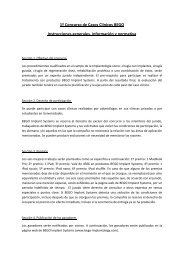
![Folleto del curso [3449823B/pdf] - BEGO](https://img.yumpu.com/49168777/1/184x260/folleto-del-curso-3449823b-pdf-bego.jpg?quality=85)
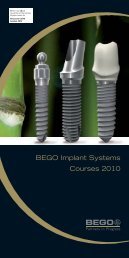
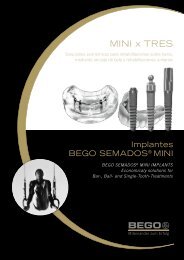
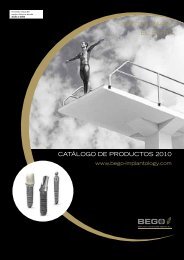
![Folleto del curso [1975602B/pdf] - BEGO](https://img.yumpu.com/35748327/1/190x190/folleto-del-curso-1975602b-pdf-bego.jpg?quality=85)
